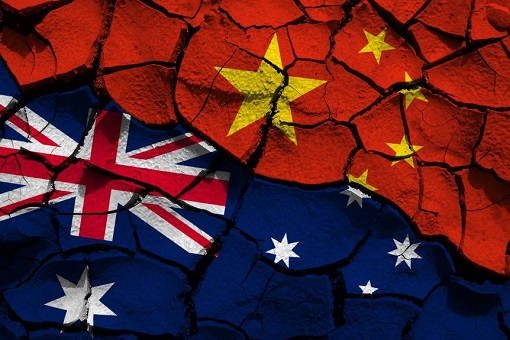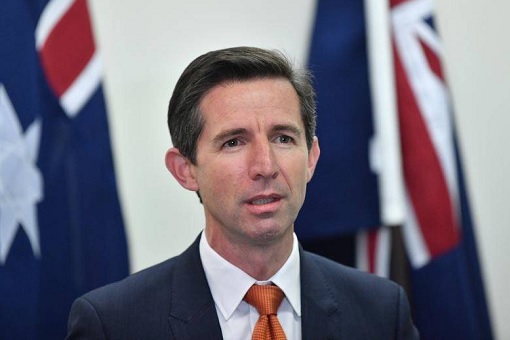Australia was hoping that by signing the China-backed Regional Comprehensive Economic Partnership (RCEP) deal on Sunday, it will automatically fix, or at least improve the country’s strained relations with China. If only it was so easy. It would take more than an insignificant deal like RCEP, of which the direct economic benefits are limited, to make the Chinese happy.
Australia’s Minister for Trade, Tourism and Investment Simon Birmingham said – “This is an incredibly important agreement in terms of the timing for when it occurs. Australia is a country where one in five jobs relies upon trade, and we know that better access for our farmers and businesses means more jobs for Australians overall.”
Canberra desperately wanted to reset economic relations with Beijing, and Mr Birmingham had openly admitted it. In reality, the RCEP trade deal, signed by China and 14 other Asia-Pacific countries, including the 10-member ASEAN (Association of Southeast Asian Nations), is seen as nothing but a move that promotes and elevates China’s political and economic influence in the region.

True, RCEP is essentially the world’s largest trade agreement, covering a massive market of 2.2 billion people and US$26.2 trillion of global output – about 30% of the worldwide population and 30% of global gross domestic product (GDP). In fact, it’s larger than the European Union and United States-Mexico-Canada Agreement (USMCA). But the economic benefits would take years to materialize.
First mooted in 2011, RCEP was aimed at strengthening trade ties between China and others with ASEAN members. It was launched a year later (2012) at a time when the Obama administration was pushing for another major trade pact – the Trans-Pacific Partnership (TPP). As China was excluded in the TPP, the RCEP was Beijing’s counter to American influence in Asia-Pacific.
Naturally, when Donald Trump pulled the U.S. out of the TPP in 2017, largely to spite Barack Obama, China did not see the urgency in pushing for RCEP, until now after the defeat of President Trump in his re-election. Joe Biden could revive the TPP, which has since become the CPTPP (Comprehensive and Progressive Agreement for Trans-Pacific Partnership).

In general, the RCEP deal would lower tariffs and other barriers to the trade of goods among the countries who signed the deal. But there’s a reason why RCEP is called a “very low-grade treaty” that lacks the scope and focus like TPP. For a start, RCEP doesn’t require its members to liberalize their economies and protect labor rights, let alone environmental standards and intellectual property.
Besides, more than 70% of trade among the 10 ASEAN countries are already conducted with zero tariffs. Hence, it’s not an exaggeration to say RCEP is more of a cosmetic deal than a real trade deal. China is driving RCEP but not a member of TPP, while America was driving TPP but not a member of RCEP. Therefore, RCEP and TPP are just a proxy war between China and the U.S.
Mr Birmingham himself described RCEP as a “hugely symbolically significant agreement”. More importantly, he expressed his disappointment that India did not sign the deal – the only country in the grouping with which Australia does not have a free trade deal. Heck, Michele O’Neil, the Australian Council of Trade Unions president, said the Morrison government doesn’t even know if RCEP will create “a single job in Australia”.

As the Australian trade and investment minister tried to pass the ball to China, saying the “ball is in China’s court to come to the table for that dialogue”, Chinese Ministry of Foreign Affairs spokesperson Zhao Lijian told a press conference on Nov 17 the three major problems why China-Australia relations are facing difficulties that couldn’t be fixed with RCEP.
First, Beijing accused Canberra of blatantly violating the basic norms of international relations, has time and again made mistakes on issues concerning China’s core interests like Hong Kong, Xinjiang and Taiwan. China said its people were hurt when Australia exploited platforms like the Human Rights Council to interfere in its internal affairs.
Second, without evidence, some people in Australia slandered and accused China of engaging in so-called “intervention and infiltration” activities in Australia. Beijing highlighted that Australia was the first in banning Chinese companies from participating in its 5G network and repeatedly prevented Chinese companies from investing in Australia under the guise of “national security”.

Third, Beijing was not impressed that Canberra used the Coronavirus pandemic to engage political manipulation by promoting “independent international inquiry”. This, of course, refers to Prime Minister Scott Morrison’s campaign in April, urging top allies France, Germany and New Zealand to pressure China to give the foreign countries the “weapons inspector-like” powers to investigate the outbreaks.
However, China mocked Australia of parroting U.S. President Donald Trump in its call for an inquiry to determine the origins of Covid-19, despite Morrison’s own admission that he had no evidence to suggest the disease originated in a laboratory in the Chinese city of Wuhan. Only Trump said he was convinced the virus may have originated in the Chinese virology lab.
So in April, Chinese Ambassador to Australia Cheng Jingye warned the Morrison government that its dangerous manoeuvre would spark a consumer boycott against Australian goods. Beijing made good on its promise, slapping an 80.5% tariff on all Australian barley grain in May after banning imports from four major Australian beef suppliers, allegedly over labelling issues.

Australia earned A$9.5 billion alone in beef export, followed by non-beef meat (A$5.2 billion). The Chinese imported over 2.5 million tonnes of Australian barley in 2018-19 – more than half of Australian total barley exports. The 80.5% tariff on all Australian barley would cost the industry a whopping A$500 million per annum – a whopping A$2.5 billion over the next 5 years as imposed by Beijing.
Global Times, Beijing’s mouthpiece, warned that China has the power to hurt the Australian economy, but won’t fire the first shot. It then moved on to escalate the trade tensions by imposing new customs inspection procedures on Australian iron ore imports. The Aussie’s iron ore export to China in 2018-19 was worth a jaw-dropping A$63 billion, not to mention A$17 billion of natural gas and A$14 billion of coal.
The next month (June), China targeted the country’s tourism and education sectors. Chinese tourists were advised to stay away from Australia. According to the Australian Bureau of Statistics figures, 1.4-million (1,458,500) Chinese tourists visited Australia in the 12 months between December 2018 and November 2019, generating a cool A$12 billion a year in revenue.

In the same month, armed with “racist attacks against Asians” mantra, Beijing warned its students to reconsider plans to study in the country.The threat would punch a hole in the Australian’s A$37.6 billion education businesses. That is on top of a new modelling revealed by the Australian university sector that showed it will lose up to A$16 billion by 2023 due to the impact of Coronavirus.
In October, after China’s customs authorities told local steelmakers and power plants to stop importing Australian coal, dealing a blow to the A$14 billion industry, the A$2 billion cotton industry was targeted. By November, Chinese import agents warned their clients they had been informed that no Australian shipments of wheat, barley, sugar, red wine, timber, wool, lobster and copper ores would be cleared.
The ban on Australian wheat delivered a blow to A$560 million (US$400 million) worth of the agricultural export to China. The Australian fishing industry too was being dragged into the China-Australia trade tensions when its rock lobsters are now being targeted. China accounted for 94% of Australian rock lobster exports worth A$752 million(US$527 million) in 2018-19.

It’s too bad that Australia’s largest trading partner for timber and wood products happens to be China again. The ban would punch another export hole worth a staggering A$1.9 billion. Australian grape and wine industry worth A$1.2 billion in exports to China are also affected with the latest ban. Even sugar was targeted despite it was only worth A$100 million based on last year’s export to China.
In addition to sugar, copper ore also lost its biggest customer as it joined the blacklist of Australian products. Australia is the world’s third-biggest copper exporter and half of its copper goes to China – an export worth A$3.7 billion. The country is still the world’s most China-dependent developed economy, even though it has been seeking to reduce its reliance through trades with other nations.
Still, despite the three critical issues unveiled by Beijing that affects the bilateral relations, PM Scott Morrison defiantly insisted today (Nov 19) that Australia will always set its own laws and its own rules according to the country’s national interests. But trying to force China to surrender to “weapons inspector-like” investigations, as if it was a Saddam Hussein regime, certainly sounds suspicious.

As Morrison stubbornly continues to poke the panda, reaching more joint military operations and exercises with Japanese Prime Minister Yoshihide Suga to push back against China’s influence in the Asia-Pacific region, Australian Trade Minister Birmingham and other ministers still can’t get through on the telephone to their Chinese counterparts. Zhao Lijian made it clear that no truce was in sight with Australia.
Other Articles That May Interest You …
- Australia’s Economy Being Hit Again – China Bans Wheat, Lobster, Barley, Sugar, Wine, Timber, Coal, Copper
- China Punish Australia Again – Recession-Hit Aussie Saw Its A$2 Billion Cotton Industry Targeted
- Australia Upset! – China Now Uses “Asian Discrimination” To Target Aussie’s A$38 Billion Education Industry
- Coronavirus Inquiry Backfired On Aussie – China Slaps Tariffs, Warns It Has The Power To Hurt Australia Economy
- Lawsuits For Trillions Of Dollars Against China Over Spread Of Coronavirus – Here’s Why It’s A Waste Of Time
- IMF – The “Great Lockdown” Is Set To Triggers The World’s Worst Recession Since The 1929 Great Depression
- 3 Coronavirus Variants Discovered – Surprisingly, “Type-A” Found In Americans, Wuhan’s Type-B And Type-C In Europe
- Arabs Conspiracy Theories – Coronavirus Is The U.S. & Israel Biological Warfare To Cripple China’s Economy & Reputation
- National Security Threat – China’s Huawei & ZTE “5G Technology” Banned In Australia
- Corruption In Australia? – Huawei The Biggest Sponsor Of Australian Politicians

|
|
November 19th, 2020 by financetwitter
|


|

|

|

|

|

|




























Comments
Add your comment now.
Leave a Reply